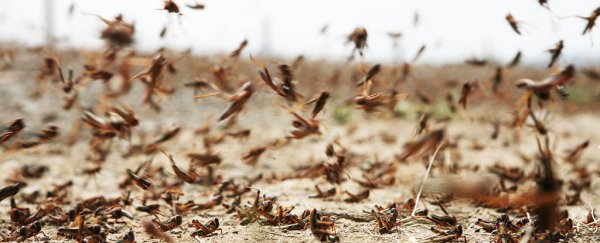If a swarm of locusts is indeed a symbol of wrath, then the climate in northern Africa must be seriously bent out of shape.
Today, Kenya is experiencing the worst outbreak of desert locusts in 70 years, with a plague so thick in some areas, locals say they can barely see through the hundreds of millions of fluttering bugs.
While harmless to the touch, according to the Food and Agriculture Organization (FAO), the situation is "extremely serious" and an "unprecedented threat" to the food security and livelihoods of those in the Horn of Africa.
"Even cows are wondering what is happening," farmer Ndunda Makanga told The South China Morning Post.
The locusts started gathering last June in eastern Ethiopia and northern Somalia, before quickly developing into the most serious infestation that region has experienced in the past 25 years.
2019 was one of the wettest years ever in East Africa, and warm temperatures and heavy rainfall created the perfect environment for an outbreak. Now, each day, more and more locusts slip over into Ethiopia, joining a mass of insects so large it's been compared to the city of Moscow.
FAO claims its size and destructive potential is like nothing we've seen before. These voracious pests threaten to destroy pastures and crops, and apparently, even a small swarm can consume enough food for 35,000 people in a single day.
Coming off a year of El Niño-induced drought, further deterioration of food security could spell disaster. In Kenya, about 70,000 hectares of land are already infested, and FAO says it doesn't see the issue abating until at least June 2020.
"Communities in Eastern Africa have already been impacted by extended droughts, which have eroded their capacities to grow food and make a living," said FAO's director general QU Dongyu.
"We need to help them get back on their feet, once the locusts are gone."
But if the rain keeps falling and the weather stays warm, experts think this already massive swarm could "swell exponentially and spill over" into more countries in East Africa. After all, these bugs are known to travel up to 150 kilometres a day (90 miles), and in this particular case, it's not unfeasible that this bunch swells by nearly 500 fold.
Resources are already strained by the size of the plague, which is so thick in Ethiopia, a plane had to be diverted after locusts reduced visibility from the cockpit windows.
Worst locust invasion to hit East Africa in 25 years grounds Ethiopia Airlines jet, which was a spattered mess with damaged engines after flying through swarm. Crops hit hard, with UN teams warning of food shortages. Locusts number 40million per sq km in some parts of East Africa pic.twitter.com/Ka4bReoUw6
— James Hall (@hallaboutafrica) January 15, 2020
Constantly on the lookout for fresh food and warm, rainy conditions, some swarms have already migrated to Iran. Egypt, Eritrea, Saudi Arabia and Yemen are at risk of similar swarms.
"The speed of the pest's spread and the size of the infestations are so far beyond the norm that they have stretched the capacities of local and national authorities to the limit," a recent FAO press release reads.
"Given the scale of the current swarms, aerial control is the only effective means to reduce the locust numbers."
To scale up pesticide spraying efforts, the United Nations humanitarian chief has released US$10 million and the UN itself is seeking a further $70 million from international donors, based on FAO estimates.
"This devastating locust outbreak is starting to destroy vegetation across East Africa with alarming speed and ferocity," said UN humanitarian chief Mark Lowcock.
"Vulnerable families that were already dealing with food shortages now face the prospect of watching as their crops are destroyed before their eyes. We must act now."
